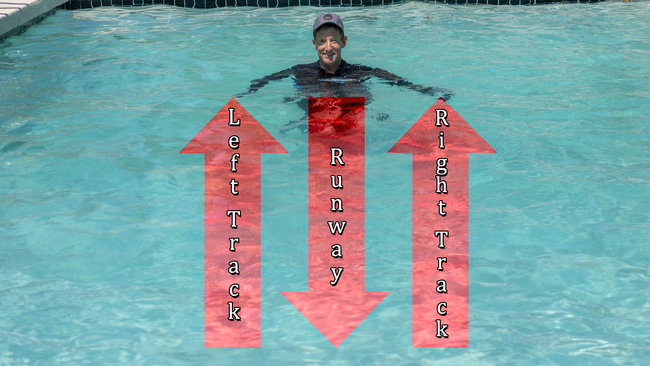Exercising in water is different than exercising on land. The drag forces you encounter due to water’s viscosity increases resistance for enhanced toning, endurance and overall results that help people move better and live better. Traveling exercises will be more intense in the water’s viscosity than exercising in place. H2O Move showcases the power of travel by applying the Travel Challenge to 18 different exercises.
The Travel Challenge
Traveling exercises has been a theme in three of my last videos, Water Exercise 321, Deep 321 and Deep-Up-Down-Run. Exercising on my own in the pool, I prefer a workout that incorporates the length of my condo pool, traveling back and forth. I love being able to MOVE through the water without the pain or discomfort I would experience on land. Traveling an exercise is harder than performing it in place thanks to the water’s resistance. Changing travel direction builds more intensity as it reverses the motion of the water. H2O Move highlights the power of travel and the importance of maximizing the water’s unique properties.
Overcoming Inertia
Newton’s law of Inertia states that an object remains stationary unless a force causes it to move. Overcoming inertia increases intensity with a change in status quo. In water exercise, there are three ways to overcome inertia with movement. Limb inertia increases intensity with changes in arm and leg patterns. The more frequent the changes, the more intensity. Total-body inertia increases intensity with travel. As you travel, your body has to start and stop, accelerate and de-accelerate as you move forward and backwards, laterally, diagonally and circularly. Constant travel will increase intensity. Performing moves in place will decrease intensity. Lastly, if class participants move in the same direction and then turn around and immediately travel back, it will require more effort to travel back in the current they created. Constant movement creates constant water in motion. Watch: Overcoming inertia to increase intensity.
The Travel Box
H20 Move features 18 exercises, six for upper body, six for lower body and six for core. Each exercise is performed in place for 30 seconds and then traveled forwards, backwards and laterally for 60 seconds. Minimal space is required for the travel. If you exercise in a very small space, the exercises can be performed in place with directional changes (quarter turns). These directional changes are referred to as the “Travel Box” in the video. Moves are traveled forwards and backwards on the imaginary runway. Lateral travel occurs with quarter turns up the right or left track. View the Travel Box in the photo below.
Deep or Shallow
Have a preference for deep or shallow water exercise? You get to choose the depth for this workout! It can be done in either. I chose to film it deep because I prefer deep water workouts and most of the of the PoolFit videos feature shallow water exercise. Please keep in mind, deep water exercise requires a flotation belt. If you aren’t sure why, watch the video below.
Webbed Gloves
Drag equipment can be used in this workout. Drag equipment includes webbed gloves and the Aqualogix upper body belles and lower body fins. Aside from the extra resistance, I love using webbed gloves in deep water because I tend to be a sinker and the gloves add an upward propulsion that assists me in deep water.
Ready for the Travel Challenge? If you have access to both deep and shallow water in your classes, try this workout in both depths and see if your students have a preference. One thing is certain, they will never think about Newton’s law of inertia the same way!